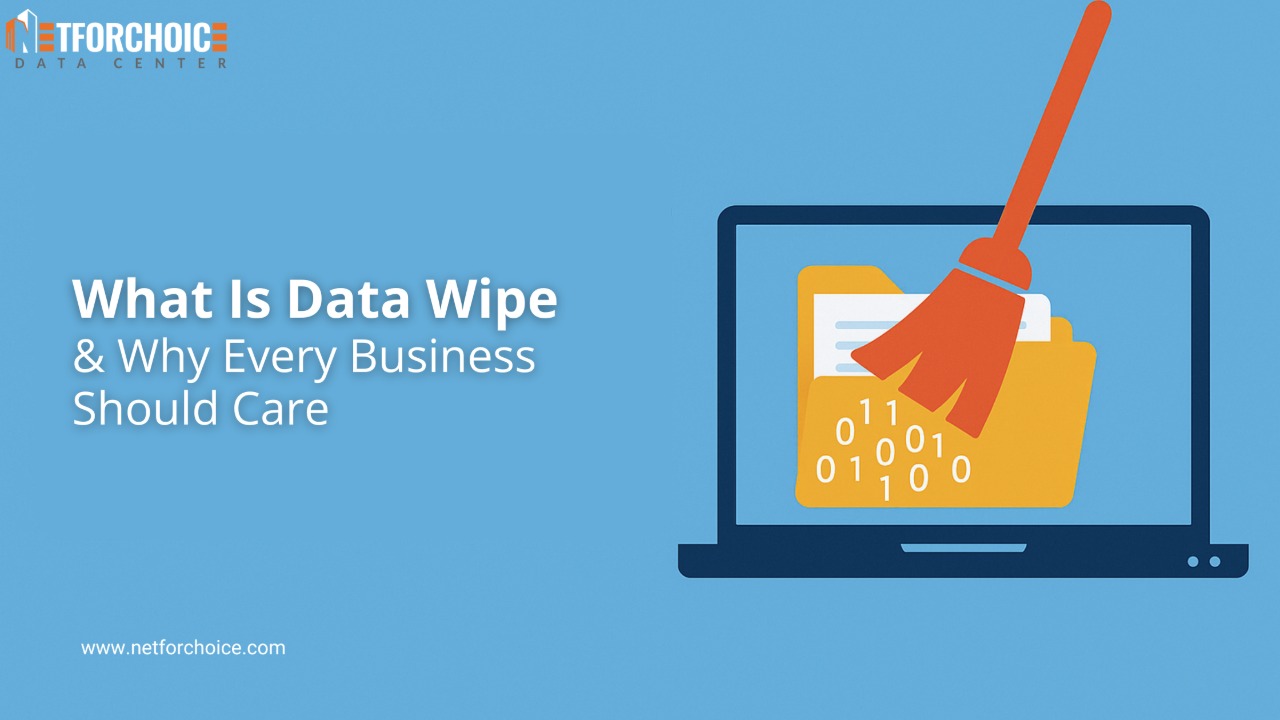What Is Data Wipe & Why Every Business Should Care

Data Wipe is an overlooked symbol of digital security in a world where data is worth as much as money. The way you remove your data can make or break your security, compliance, and reputation, no matter whether you’re a small business, healthcare provider, or enterprise handling client information.
How does a data wipe work? There’s more to it than simply formatting a hard drive or clicking “delete.” The process of permanently deleting data from storage devices so that it cannot be recovered in any way is known as data wiping. For companies that handle sensitive data, such as client records, financial information, employee information, or proprietary files, this secure data erasure technique is essential.
Let’s examine data wipe in more detail, including its benefits and the reasons why every modern company must implement safe and approved data erasure solutions.
What is data wipe?
The process of safely and permanently deleting data from a storage device so that no forensic tools, software, or hardware can recover it is known as data wiping. Data wiping uses specific algorithms to repeatedly overwrite the actual storage sectors, making recovery impossible, in comparison with standard file deletion or formatting, which only removes the file’s directory path.
When it comes to recycling, reusing, or getting rid of gadgets like hard drives, SSDs, USBs, and even smartphones or tablets, this procedure is especially crucial. There are significant risks because even erased files can be recovered with data recovery tools if proper data erasure is not done.
How Does Secure Data Erasure Work?
Step-by-Step Process of Secure Data Wipe
- Selection of Wiping Method: The program chooses which device or partition to delete.
- Overwriting Passes: The system takes over each storage sector with either a specific pattern or random data. This can vary from one to seven or more passes, depending on the approach (e.g., DoD 5220.22-M or NIST 800-88).
- Phase of Verification: Some tools confirm the overwrite by checking each sector.
- Report Generation: Tamper-proof reports verifying the effectiveness of erasure are produced by certified data wipe tools.
Because it ensures that no file remnants are left behind, this procedure is a reliable approach in sectors like IT asset disposition (ITAD), healthcare, finance, and defense.
Benefits of Secure Data Wipe for Businesses
Secure data erasure is not only best practice but also required when retiring a server, selling an old laptop, or reassigning internal systems. The main arguments for why secure data erasure should be a top priority for any company are listed below.
- Stops Data Breach
Cybercriminals can profit greatly from old data. Sensitive client or company information may end up in the wrong hands if improperly erased. Secure data wipe reduces risk by ensuring the total deletion of private documents.
- Assures Regulation Compliance
Strict data protection regulations, such as GDPR, HIPAA, and ISO 27001, are enforced by governments and businesses. By making sure that no traces of regulated or personal data are left on disposed of systems, secure data erasure helps you maintain compliance.
- Preserves the Image of the Brand
Even unintentional data leaks have the potential to damage your brand’s reputation and credibility. Wiping your data keeps you out of the news for the wrong reasons.
- Encourages Recycling of Eco-Friendly IT
Hardware containing sensitive data cannot be recycled or donated. Secure wiping makes it possible to donate or reuse devices in a way that promotes sustainable IT practices.
- Reduces Hardware Disposal Costs
Erasing hardware securely allows you to reuse or resell it instead of destroying it, increasing ROI without running the risk of a breach.
Best Practices for Implementing Secure Data Wipe
Adhering to secure data wiping procedures is a component of your company’s overall data governance policy, not just a checkbox. The following are recommended practices to follow:
Make use of certified data wiping software that fulfills international standards (e.g., DoD, NIST).
- Keep track of audit trails and reports for each device that has been erased.
- Make sure data erasure tasks are handled by qualified staff.
- Establish regular procedures for all departments to dispose of data.
- To ensure that no residual data is left, conduct audits at random.
Common Use Cases of Data Wipe Across Industries
- Healthcare
Data from diagnostic devices and patient records are disposed of by healthcare clinics and hospitals. HIPAA compliance is guaranteed by a secure data wipe.
- BFSI
Financial institutions and banks handle large amounts of sensitive transactional data. Here, a breach could cost millions of dollars. Secure hardware disposal is ensured by data wiping.
- Learning
Colleges and schools frequently upgrade or recycle their systems. Data wiping makes sure student records don’t end up in the wrong hands.
- ITAD Companies
The best data wipe software is used by ITAD companies to provide clients with traceable and compliant destruction services.
Conclusion
Data wipe is no longer an option but a security necessity in the world of data today. Devices that are disposed of or reused improperly pose risks that can have irreversible consequences, such as data breaches, reputation loss, and compliance issues.
Companies that embrace secure data wiping not only protect their financial and legal interests but also promote responsible data handling. Buying quality and certified wiping solutions is important, and NetForChoice’s BitWipe is an example. With full reports, support for multiple devices, and compliance with international standards like NIST and DoD, BitWipe offers enterprise-level, certified data wiping solutions.
Ensure data does not travel with your devices, whether you’re growing your IT infrastructure or simply removing aged systems. Make wise decisions. Select “secure.” Select approved data deletion programs such as BitWipe.
FAQs
- Is data wiping the same as deleting a file?
No. When a file is deleted, its directory path is gone, but the data itself can still be recovered. Data wiping makes the data irrecoverable by overwriting it.
- How can I determine whether a data wipe was effective?
Verification and reports are provided by certified tools such as BitWipe to verify total erasure.
- Can SSDs be wiped securely?
Yes, but because of wear-leveling, SSDs need specific algorithms. SSD-specific wipe techniques are supported by certified tools.
- If I’m reusing the device internally, do I still need to wipe the data?
Yes. Wiping prevents unwanted access to previous data, particularly in regulated industries or when the device changes hands.
- What separates data wiping from formatting?
Formatting prepares a disc for reuse but doesn’t erase data securely. Wiping ensures complete data destruction.
Submit Your Query

